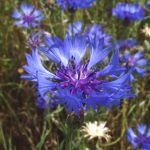| Common Name: |
Bluebottle |
| Other Names: |
Cornflower, bachelor's buttons |
| Botanical Name: |
Centaurea cyanus |
| Genus: |
Centaurea |
| Family: |
Asteraceae |
| Native Location: |
Europe, Mediterranean regions. |
| Cultivation: |
Well-drained soil in sun. Flowers may be affected by petal blight; leaves may be damaged by rust. |
| Propagation: |
By seed sown in situ in autumn or spring. Seedlings do not transplant well. |
| Harvest: |
Flowers are cut as they open and dried whole or as florets, according to use. |
| Variations: |
Blue Diadem
Has double blue flowers to 6cm (2½in) across.
Height:75cm (30in)
Florence Series
Has flowers in shades of blue, pink, carmine, and white
Height: 35cm (14in) |
| Height: |
20cm-1m (8-36in) |
| Width: |
15-30cm (6-12in) |
| Hardiness: |
Hardy |
| Parts Used: |
Flowers |
| Properties: |
An astringent herb that reduces inflammation. |
| Medicinal Uses: |
Externally for corneal ulcers, conjunctivitis, minor wounds, or mouth ulcers. |
| Culinary Uses: |
Florets may be used fresh in salads |
| Economic Uses: |
Extracts of cornflower are added to hair shampoos and rinses. Florets may be dried for potpourris. |
| Bibliography: |
Encyclopedia of Herbs by Deni Brown Copyright © 1995, 2001 Dorling Kindersley Limited Pg 161-162 |
